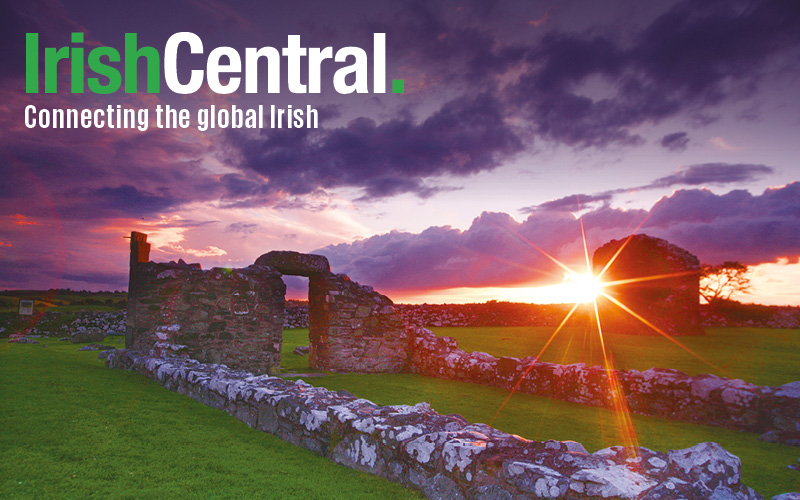| Aoife O’Donovan and Karan Casey perform last week. (Photo by Erin Baiano/Irish Arts Center) |
On any given night in New York City terrific music and entertainment choices abound, but one place seems to be having more than its share of successes in recent years and that would be the Irish Arts Center in Hell’s Kitchen.
This past week it played host to the Masters in Collaboration series in its seventh edition featuring singers Karan Casey and Aoife O’Donovan who performed on Friday, Saturday and Sunday nights after a scene setting interview night on Wednesday of last week.
Once again this innovative opportunity to peer into the creative process of dynamic performers in the Irish music scene is unparalleled in my opinion on either side of the Atlantic.
There was an air of excitement and buzz in the 99-seat Donaghy Theater that serves as the primary venue for shows at the Irish Arts Center, presently engaged in a multi-million dollar expansion campaign aimed for completion in 2015-2016.
The mission of the Masters in Collaboration series is to provide a space and time for two artists to explore their own work and one another’s for the similarities and differences that make them optimum mates for the week-long gig. Another objective is to see what the twin synergy might produce in the way of new material that draws from the strengths of each individual.
“It is a luxury to have the time at this stage of my career to spend a week in New York with another performer like Aoife because I like her spirit and admire her greatly for the choices she has made in her own career,” Casey told me by phone in advance of her trip to New York.
O’Donovan is 15 years younger than Casey, but because of her own background in a very musical household in Newton, Massachusetts and musical education she has been professionally engaged since her teenage years.
The series always opens the door a little bit with the Wednesday night interview by series creator Dr. Mick Moloney, who uses an affable conversational format to give the audience enough of a performer profile to see why the pairing shows the potential to be quite entertaining by week’s end.
This edition was no different and was quite relaxed and informal, yielding enough information to whet the appetite for what was to come later in the week.
Casey arrived in New York over 20 years ago from her native Waterford with a background in singing in churches and smallish clubs at home and ready to study jazz, having been influenced by Ella Fitzgerald and Sarah Vaughan.
She also did some Irish singing with a group called Atlantic Bridge (featuring Patty Furlong, Fiona Doherty and Brendan Dolan) where she was discovered by Seamus Egan and Winnie Horan, the founding members of Solas who recruited her for their formidable and trail-blazing band established in the mid-nineties.
After four and half years and three smash CDs with Solas, she moved back to Ireland with her partner Niall Vallely and started a solo career as well as a family when her daughter Muireann, now 13, was born (now 13).
Also worth noting was a chance meeting at the Catskills Irish Arts Week with the renown Dublin folk singer Frank Harte, who loved her voice and passion for singing but recognized her dearth of traditional Irish songs. He took her under his wing, as he had so many others, and helped develop her craft as a key mentor from then onwards.
O’Donovan grew up around music of all types in the greater Boston area, gravitating to folk music under the direct influence of her musician parents Lindsay and Brian O’Donovan, who has presented a very sophisticated radio program on Boston’s WGBH radio dial called Celtic Sojourn where he excels in exploring the “roots and branches of Celtic music” as he is wont to say on air.
American roots music, or Americana as it is called now, particularly caught her fancy, and at 18 she formed a band called Crooked Still which became a popular touring band for festivals and gigs not only around the U.S. but in Europe as well.
She took the academic route, enrolling in the New England Conservatory of Music to learn more about interpreting music in the more contemporary world, and soon established herself as a vocalist with a distinctive sound either as a lead singer or as a harmonizing backup performer.
From the brief interview on stage by Moloney we learned of Casey and O’Donovan’s long friendship and mutual admiration for one another’s skills, and appreciation for being able to spend a week with one another solidifying their bonds and sparking some new work between them.
Both described themselves as diligent and hard-working when it came to crafting songs, with O’Donovan being more melody-driven at first and Casey focusing on the words that give rise to her songwriting.
Both appear to have taken chances or risks with their careers but have confidence in doing so and seemed to have avoided typecasting when it comes to what material they present in their own shows, so coming out of their comfort zone together wasn’t surprising.
I attended the Sunday night final show which the center’s executive director Aidan Connolly said “afforded the artists the opportunity time to work outside of the usual pressures of the commercial marketplace.”
Both Casey and O’Donovan relished the challenge and prepared themselves well for the weekend gigs and it showed by week’s end.
Working with accompanists Grant Gordy (guitarist with the David Grisman Band) and bass player Jacob Silver (from O’Donovan’s Crooked Still Band), they produced a solid show that showed great variety and creativity.
Since both singers are known for the special qualities of their voices, the choice of accompanists was an important enhancement for the songs they selected.
Gordy and Silver not only fulfilled their roles, but like the two singers seemed personally pleased with their arrangements despite not having a whole lot of time to prepare the material.
The end result was, perhaps, the most successful production in the series in that it came across as a fully formed show from start to finish without hesitation or uncertainty about where they were going next which is a credit to the work laid down in preparation by Casey and O’Donovan.
The delicate features of their voices at times belied their intensity and commitment to their selections, but their respective precision either in the lead role or backup harmony was unerring in the 14-song program they presented.
Starting out with a Patty Griffin song called “Mary,” they quickly established themselves and gave early notice that we were in for a treat.
They came up with several new songs during the week as they originally hoped, and dipped into pieces that each had written and performed in other spheres but with a discerning simpatico for one another’s work.
This came out effectively when Casey took to the piano to play her composition “Lovely Annie,” an ode to her mother with whom she was very close, or O’Donovan’s lead vocal and guitar work on “When I See Your Face.”
Fittingly, the two women blended voices for “A Stor Mo Chroi” which figured prominently in a spectacular showcase of Irish singers last January at the Temple Bar Trade Festival growing out of a recording produced by Dublin’s Celtic Note record store which Casey participated in.
It was notable to me because while O’Donovan doesn’t really class herself as an Irish singer, she does have a great understanding of it and on occasion can get to the heart of it through her own voice.
Since they sung this a capella you could easily feel the harmony as well as see it and hear it in the intimate space that theater provides.
And to underscore the poetic or literary value they both bring to their songs, the choice of the encore song “Wandering Aengus” from the William B. Yeats poem was brilliant and a perfect way to cap
their performance.
One song’s inclusion in the stellar program seemed most symbolic to me and expressed why these two women sing songs that matter about the universal condition in a very contemporary form. It was Scotsman Ian Sinclair’s anti-war ballad decrying politics and war, “The King’s Shilling,” only written in the 1980s but harkening back to a different historical time.
Casey has been steadfast in including it in her repertoire since learning it from her mentor Harte, right through the Solas days to the present including in a wonderful YouTube duet with the American singer James Taylor.
It was extracted from the Transatlantic Sessions series produced at Celtic Connections which emphasizes the very roots and branches of that music that underlie a series like Masters in Collaboration as well.
In presenting artists like Casey and O’Donovan, who are well versed in the tradition but unafraid to give it a modern voice, the material drawn from it is renewed but can also stand a long side newer material cut from the same cloth by thoughtful artists like this pair.
Once again the Masters in Collaboration presentation at the Irish Arts Center was one for the ages.




Comments